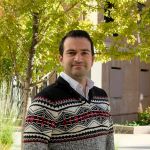Title:
The love story between particle porosity and the biomedical field. Abstract:
Engineering material porosity was initiated to harness their properties in catalysis and separation. Shortly after, adapting porosity to nanotechnology was embraced by the biomedical field: Particle porosity not only can accommodate, concentrate and protect nanocatalysts or nanotherapeutics from small molecule drugs to nucleic acids and proteins, but we have found that they also exhibit intrinsic properties that guide the interaction of the nanomaterials within their biological environment, including cell lipid membrane, uptake, biocompatibility, particle dissolution, but also to some extent their distribution in body organs. In this presentation we will first revise the basics of pore formation within silica matrices, their interaction with therapeutics and selected works by our group in bio- and catalytic applications of porous silica materials. Bio:
Achraf Noureddine is a junior assistant professor of research at the department of chemical and biological engineering at the University of New Mexico. His learning and research journey expands over three continents between Lebanon, France and USA. His research focuses on developing nanomaterials for biomedical applications ranging from cancer to obesity and predictive nanomedicine. An emphasis of his PhD and postdoc research within the groups of Wong Chi Man (ENSCM Montpellier France), Zink (UCLA, USA) and Brinker (UNM,USA) is the development and advancement of mesoporous silica materials mainly for drug delivery purposes but also for catalytic applications. He has over 30 papers, 3 book chapters and 8 patent (issued or filed). His mentorship has yielded over 25 awards for diverse trainees including high school students and teachers as well as undergraduate students. He is member of different societies including the internation sol gel science and technology, biomedical engineering and drug delivery society of Japan. |

